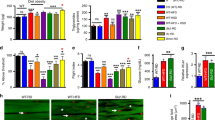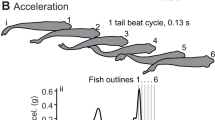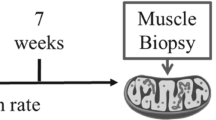Abstract
Background/Objectives:
Obesity can affect muscle phenotypes, and may thereby constrain movement and energy expenditure. Weight loss is a common and intuitive intervention for obesity, but it is not known whether the effects of obesity on muscle function are reversible by weight loss. Here we tested whether obesity-induced changes in muscle metabolic and contractile phenotypes are reversible by weight loss.
Subjects/Methods:
We used zebrafish (Danio rerio) in a factorial design to compare energy metabolism, locomotor capacity, muscle isometric force and work-loop power output, and myosin heavy chain (MHC) composition between lean fish, diet-induced obese fish, and fish that were obese and then returned to lean body mass following diet restriction.
Results:
Obesity increased resting metabolic rates (P<0.001) and decreased maximal metabolic rates (P=0.030), but these changes were reversible by weight loss, and were not associated with changes in muscle citrate synthase activity. In contrast, obesity-induced decreases in locomotor performance (P=0.0034), and isolated muscle isometric stress (P=0.01), work-loop power output (P<0.001) and relaxation rates (P=0.012) were not reversed by weight loss. Similarly, obesity-induced decreases in concentrations of fast and slow MHCs, and a shift toward fast MHCs were not reversed by weight loss.
Conclusion:
Obesity-induced changes in locomotor performance and muscle contractile function were not reversible by weight loss. These results show that weight loss alone may not be a sufficient intervention.
This is a preview of subscription content, access via your institution
Access options
Subscribe to this journal
Receive 12 print issues and online access
$259.00 per year
only $21.58 per issue
Buy this article
- Purchase on Springer Link
- Instant access to full article PDF
Prices may be subject to local taxes which are calculated during checkout




Similar content being viewed by others
References
Dickinson M, Farley C, Koehl M, Kram R . How animals move: an integrative view. Science 2000; 288: 100–106.
Bassel-Duby R, Olson EN . Signaling pathways in skeletal muscle remodeling. Annu Rev Biochem 2006; 75: 19–37.
O’Neill HM, Holloway GP, Steinberg GR . AMPK regulation of fatty acid metabolism and mitochondrial biogenesis: Implications for obesity. Mol Cell Endocrinol 2013; 366: 135–151.
Pérez LM, Pareja-Galeano H, Sanchis-Gomar F, Emanuele E, Lucia A, Gálvez BG . ‘Adipaging’: ageing and obesity share biological hallmarks related to a dysfunctional adipose tissue. J Physiol (Lond) 2016; 594: 3187–3207.
Gordon AM, Homsher E, Regnier M . Regulation of contraction in striated muscle. Physiol Rev 2000; 80: 853–924.
Song Y, Cone RD . Creation of a genetic model of obesity in a teleost. FASEB J 2007; 21: 2042–2049.
Oka T, Nishimura Y, Zang L, Hirano M, Shimada Y, Wang Z et al. Diet-induced obesity in zebrafish shares common pathophysiological pathways with mammalian obesity. BMC Physiol 2010; 10: 21.
Rodgers J, Lerin C, Gerharthines Z, Puigserver P . Metabolic adaptations through the PGC-1α and SIRT1 pathways. FEBS Lett 2008; 582: 46–53.
Canto C, Jiang LQ, Deshmukh AS, Mataki C, Coste A, Lagouge M et al. Interdependence of AMPK and SIRT1 for metabolic adaptation to fasting and exercise in skeletal muscle. Cell Metab 2010; 11: 213–219.
Price NL, Gomes AP, Ling AJY, Duarte FV, Martin-Montalvo A, North BJ et al. SIRT1 Is required for AMPK activation and the beneficial effects of resveratrol on mitochondrial function. Cell Metab 2012; 15: 675–690.
Ramadori G, Fujikawa T, Anderson J, Berglund ED, Frazao R, Michán S et al. SIRT1 deacetylase in SF1 neurons protects against metabolic imbalance. Cell Metab 2011; 14: 301–312.
Pfluger PT, Herranz D, Velasco-Miguel S, Serrano M, Tschöp MH . Sirt1 protects against high-fat diet-induced metabolic damage. Proc Natl Acad Sci USA 2008; 105: 9793–9798.
Jheng H-F, Huang S-H, Kuo H-M, Hughes MW, Tsai Y-S . Molecular insight and pharmacological approaches targeting mitochondrial dynamics in skeletal muscle during obesity. Ann NY Acad Sci 2015; 1350: 82–94.
James RS, Altringham JD, Goldspink DF . The mechanical-properties of fast and slow skeletal-muscles of the mouse in relation to their locomotory function. J Exp Biol 1995; 198: 491–502.
Syme DA. Functional Properties of Skeletal Muscle In Fish Physiology Volume 23 Academic Press, 2005. pp 179–240.
Tallis J, Hill C, James RS, Cox VM, Seebacher F . The effect of obesity on the contractile performance of isolated mouse soleus, EDL and diaphragm muscles. J Appl Physiol 2017; 122: 170–181.
Tanner CJ, Barakat HA, Dohm GL, Pories WJ, MacDonald KG, Cunningham PRG et al. Muscle fiber type is associated with obesity and weight loss. Am J Physiol Endocrinol Metab 2002; 282: E1191–E1196.
Stuart CA, McCurry MP, Marino A, South MA, Howell MEA, Layne AS et al. Slow-twitch fiber proportion in skeletal muscle correlates with insulin responsiveness. J Clin Endocrinol Metab 2013; 98: 2027–2036.
DeNies MS, Johnson J, Maliphol AB, Bruno M, Kim A, Rizvi A et al. Diet-induced obesity alters skeletal muscle fiber types of male but not female mice. Physiol Rep 2014; 2: e00204.
Garland T, Schutz H, Chappell MA, Keeney BK, Meek TH, Copes LE et al. The biological control of voluntary exercise, spontaneous physical activity and daily energy expenditure in relation to obesity: human and rodent perspectives. J Exp Biol 2011; 214: 206–229.
Browning RC, Baker EA, Herron JA, Kram R . Effects of obesity and sex on the energetic cost and preferred speed of walking. J Appl Physiol 2006; 100: 390–398.
Larsson UE, Mattsson E . Functional limitations linked to high body mass index, age and current pain in obese women. Int J Obes 2001; 25: 893–899.
Maffiuletti NA, Ratel S, Sartorio A, Martin V . The impact of obesity on in vivo human skeletal muscle function. Curr Obes Rep 2013; 2: 251–260.
Tallis J, James RS, Little AG, Cox VM, Duncan MJ, Seebacher F . Early effects of ageing on the mechanical performance of isolated locomotory (EDL) and respiratory (diaphragm) skeletal muscle using the work-loop technique. Am J Physiol Regul Integr Comp Physiol 2014; 307: R670–R684.
Yang WS, Lee WJ, Funahashi T, Tanaka S, Matsuzawa Y, Chao CL et al. Weight reduction increases plasma levels of an adipose-derived anti-inflammatory protein, adiponectin. J Clin Endocrinol Metab 2001; 86: 3815–3819.
Esposito K, Pontillo A, Di Palo C, Giugliano G, Masella M, Marfella R et al. Effect of weight loss and lifestyle changes on vascular inflammatory markers in obese women: a randomized trial. JAMA 2003; 289: 1799–1804.
Nitti MD, Hespe GE, Kataru RP, García Nores GD, Savetsky IL, Torrisi JS et al. Obesity-induced lymphatic dysfunction is reversible with weight loss. J Physiol (Lond) 2016; 594: 1–15.
Petersen KF, Dufour S, Befroy D, Lehrke M, Hendler RE, Shulman GI . Reversal of nonalcoholic hepatic steatosis, hepatic insulin resistance, and hyperglycemia by moderate weight reduction in patients with type 2 diabetes. Diabetes 2005; 54: 603–608.
Jiang S, Wang Q, Huang Z, Song A, Peng Y, Hou S et al. Gastric bypass surgery reverses diabetic phenotypes in Bdnf-deficient mice. Am J Pathol 2016; 186: 2117–2128.
Li K, Zou J, Ye Z, Di J, Han X, Zhang H et al. Effects of bariatric surgery on renal function in obese patients: a systematic review and meta analysis. PLoS One 2016; 11: e0163907–e0163918.
Clark TD, Sandblom E, Jutfelt F . Aerobic scope measurements of fishes in an era of climate change: respirometry, relevance and recommendations. J Exp Biol 2013; 216: 2771–2782.
Seebacher F, Borg J, Schlotfeldt K, Yan Z . Energetic cost determines voluntary movement speed only in familiar environments. J Exp Biol 2016; 219: 1625–1631.
Seebacher F, Ward AJW, Wilson RS . Increased aggression during pregnancy comes at a higher metabolic cost. J Exp Biol 2013; 216: 771–776.
Larsen S, Nielsen J, Hansen CN, Nielsen LB, Wibrand F, Stride N et al. Biomarkers of mitochondrial content in skeletal muscle of healthy young human subjects. J Physiol (Lond) 2012; 590: 3349–3360.
Garenc C, Silversides F, Guderley H . Burst swimming and its enzymatic correlates in the threespine stickleback (Gasterosteus aculeatus: full-sib heritabilities. Can J Zool 1998; 76: 680–688.
Hammer C . Fatigue and exercise tests with fish. Comp Biochem Physiol A 1995; 112: 1–20.
Wakeling JM, Cole NJ, Kemp KM, Johnston IA . The biomechanics and evolutionary significance of thermal acclimation in the common carp Cyprinus carpio. Am J Physiol Regul Integr Comp Physiol 2000; 279: R657–R665.
Seebacher F, Little AG, James RS . Skeletal muscle contractile function predicts activity and behaviour in zebrafish. J Exp Biol 2015; 218: 3878–3884.
James RS, Young IS, Cox VM, Goldspink DF, Altringham JD . Isometric and isotonic muscle properties as determinants of work loop power output. Pflüg Arch 1996; 432: 767–774.
Altringahm JD, Wardle CS, Smith CI . Myotomal muscle function at different locations in the body of a swimming fish. J Exp Biol 1993; 182: 191–206.
Josephson R . Contraction dynamics and power output of skeletal muscle. Annu Rev Physiol 1993; 55: 527–546.
Mendez J, Keys A . Density and composition of mammalian muscle. Metabolism 1960; 9: 184–188.
Wheeler RE, Torchiano M Permutation tests for linear models in R. R Package Version. 2016.
R Development Core Team R: A Language and Environment for Statistical Computing. R Foundation for Statistical Computing: Vienna, Austria, 2013.
Drummond GB, Vowler SL . Different tests for a difference: how do we do research? J Physiol (Lond) 2012; 590: 235–238.
Little AG, Kunisue T, Kannan K, Seebacher F . Thyroid hormone actions are temperature-specific and regulate thermal acclimation in zebrafish (Danio rerio. BMC Biol 2013; 11: 26.
Lieschke GJ, Currie PD . Animal models of human disease: zebrafish swim into view. Nat Rev Gen 2007; 8: 353–367.
Schlegel A, Gut P . Metabolic insights from zebrafish genetics, physiology, and chemical biology. Cell Mol Life Sci 2015; 72: 2249–2260.
McClelland GB, Craig PM, Dhekney K, Dipardo S . Temperature- and exercise-induced gene expression and metabolic enzyme changes in skeletal muscle of adult zebrafish (Danio rerio. J Physiol (Lond) 2006; 577: 739–751.
Palstra AP, Tudorache C, Rovira M, Brittijn SA, Burgerhout E, van der Thillart GEEJM et al. Establishing zebrafish as a novel exercise model: swimming economy, swimming-enhanced growth and muscle growth marker gene expression. PLoS One 2010; 5: e14483–e14489.
Hasumura T, Meguro S . Exercise quantity-dependent muscle hypertrophy in adult zebrafish (Danio rerio. J Comp Physiol B 2016; 186: 603–614.
Shimada Y, Kuninaga S, Ariyoshi M, Zhang B, Shiina Y, Takahashi Y et al. E2F8 promotes hepatic steatosis through FABP3 expression in diet-induced obesity in zebrafish. Nutr Metab (Lond) 2015; 12: 17.
Nguyen M, Yang E, Neelkantan N, Mikhaylova A, Arnold R, Poudel MK et al. Developing ‘integrative’ zebrafish models of behavioral and metabolic disorders. Behav Brain Res 2013; 256: 172–187.
Montalbano G, Mania M, Guerrera MC, Abbate F, Laurà R, Navarra M et al. Morphological differences in adipose tissue and changes in BDNF/Trkb expression in brain and gut of a diet induced obese zebrafish model. Annals Anat 2016; 204: 36–44.
Michel M, Page-McCaw PS, Chen W, Cone RD . Leptin signaling regulates glucose homeostasis, but not adipostasis, in the zebrafish. Proc Natl Acad Sci USA 2016; 113: 3084–3089.
van der Meulen T, Schipper H, van den Boogaart JGM, Huising MO, Kranenbarg S, van Leeuwen JL . Endurance exercise differentially stimulates heart and axial muscle development in zebrafish (Danio rerio. Am J Physiol Regul Integr Comp Physiol 2006; 291: R1040–R1048.
Gundersen K . Excitation-transcription coupling in skeletal muscle: the molecular pathways of exercise. Biol Rev 2011; 86: 564–600.
Newman T, Jhinku N, Meier M, Horsfield J . Dietary intake influences adult fertility and offspring fitness in zebrafish. PLoS One 2016; 11: e0166394–21.
Bournele D, Beis D . Zebrafish models of cardiovascular disease. Heart Fail Rev 2016; 21: 803–813.
Patton EE, Dhillon P, Amatruda JF, Ramakrishnan L . Spotlight on zebrafish: translational impact. Dis Model Mech 2014; 7: 731–733.
Altringham J, Ellerby DJ . Fish swimming: patterns in muscle function. J Exp Biol 1999; 202: 3397–340.
Swank D, Rome LC . The influence of thermal acclimation on power production during swimming. II. Mechanics of scup red muscle under in vivo conditions. J Exp Biol 2001; 204: 419–430.
Anttila K . Effects of different training protocols on Ca2+ handling and oxidative capacity in skeletal muscle of Atlantic salmon (Salmo salar L.). J Exp Biol 2006; 209: 2971–2978.
Iwabu M, Yamauchi T, Okada-Iwabu M, Sato K, Nakagawa T, Funata M et al. Adiponectin and AdipoR1 regulate PGC-1α and mitochondria by Ca2+ and AMPK/SIRT1. Nature 2010; 464: 1313–1319.
Guarente L . Calorie restriction and sirtuins revisited. Genes Dev 2013; 27: 2072–2085.
Utaka S, Avesani CM, Draibe SA, Kamimura MA, Andreoni S, Cuppari L . Inflammation is associated with increased energy expenditure in patients with chronic kidney disease. Am J Clin Nutr 2005; 82: 801–805.
Hyatt J-PK, Nguyen L, Hall AE, Huber AM, Kocan JC, Mattison JA et al. Muscle-specific myosin heavy chain shifts in response to a long-term high fat/high sugar diet and resveratrol treatment in nonhuman primates. Front Physiol 2016; 7: 77.
Seebacher F, Pollard SR, James RS . How well do muscle biomechanics predict whole-animal locomotor performance? The role of Ca2+ handling. J Exp Biol 2012; 215: 1847–1853.
Watts R, McAinch AJ, Dixon JB, O'Brien PE, Cameron-Smith D . Increased Smad signaling and reduced MRF expression in skeletal muscle from obese subjects. Obesity 2013; 21: 525–528.
Bruton JD, Aydin J, Yamada T, Shabalina IG, Ivarsson N, Zhang SJ et al. Increased fatigue resistance linked to Ca2+-stimulated mitochondrial biogenesis in muscle fibres of cold-acclimated mice. J Physiol (Lond) 2010; 588: 4275–4288.
Funai K, Song H, Yin L, Lodhi IJ, Wei X, Yoshino J et al. Muscle lipogenesis balances insulin sensitivity and strength through calcium signaling. J Clin Invest 2013; 123: 1229–1240.
Bannister RA . Bridging the myoplasmic gap II: more recent advances in skeletal muscle excitation-contraction coupling. J Exp Biol 2016; 219: 175–182.
Allen DG, Lamb GD, Westerblad H . Skeletal muscle fatigue: cellular mechanisms. Physiol Rev 2008; 88: 287–332.
Garcia-Vicencio S, Coudeyre E, Kluka V, Cardenoux C, Jegu A-G, Fourot A-V et al. The bigger, the stronger? Insights from muscle architecture and nervous characteristics in obese adolescent girls. Int J Obes 2016; 40: 245–251.
Arslan-Ergul A, Adams MM . Gene expression changes in aging zebrafish (Danio rerio brains are sexually dimorphic. BMC Neurosci 2014; 15: 29.
Teasdale N, Simoneau M, Corbeil P, Handrigan G, Tremblay A, Hue O . Obesity alters balance and movement control. Curr Obes Rep 2013; 2: 235–240.
Vickers MH, Breier BH, McCarthy D, Gluckman PD . Sedentary behavior during postnatal life is determined by the prenatal environment and exacerbated by postnatal hypercaloric nutrition. Am J Physiol Regul Integr Comp Physiol 2003; 285: R271–R273.
Stodden DF, Goodway JD . The dynamic association between motor skill development and physical activity. J Phys Ed Recr Dance 2007; 78: 33–49.
Booth FW, Roberts CD, Laye MJ . Lack of exercise is a major cause of chronic diseases. Compr Physiol 2012; 2: 1143–1211.
Acknowledgements
We would like to thank Alec Simmons and Isabella Loughland for help with laboratory work. The research was supported by the University of Sydney and Coventry University, and Australian Research Council Discovery Grant DP160102260 to FS.
Author information
Authors and Affiliations
Corresponding author
Ethics declarations
Competing interests
The authors declare no conflict of interest.
Rights and permissions
About this article
Cite this article
Seebacher, F., Tallis, J., McShea, K. et al. Obesity-induced decreases in muscle performance are not reversed by weight loss. Int J Obes 41, 1271–1278 (2017). https://doi.org/10.1038/ijo.2017.81
Received:
Revised:
Accepted:
Published:
Issue Date:
DOI: https://doi.org/10.1038/ijo.2017.81
This article is cited by
-
The potential effect mechanism of high-fat and high-carbohydrate diet-induced obesity on anxiety and offspring of zebrafish
Eating and Weight Disorders - Studies on Anorexia, Bulimia and Obesity (2022)
-
Investigating a dose–response relationship between high-fat diet consumption and the contractile performance of isolated mouse soleus, EDL and diaphragm muscles
European Journal of Applied Physiology (2019)



